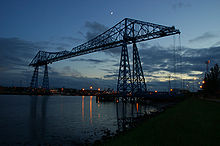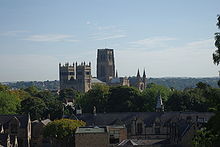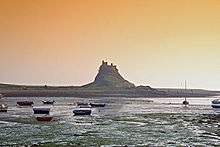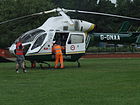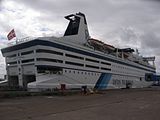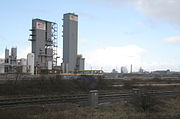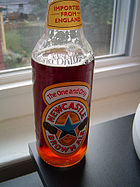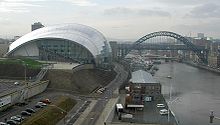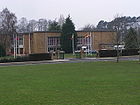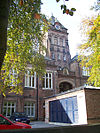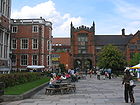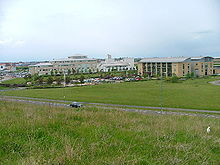- North East England
-
This article is about the region. For the European constituency, see North East England (European Parliament constituency).
North East England 
North East region shown within EnglandGeography Status Region Area
— TotalRanked 8th
8,592 km²
3,317 sq miNUTS 1 UKC Demographics Population
— Total
— DensityRanked 9th
2,515,442 (2001)
293/km²GVA per capita £15,688 (9th) Government Admin HQ Newcastle upon Tyne Leadership Association of North East Councils Regional development One NorthEast European parliament North East England Website North East England is one of the nine official regions of England. It covers Northumberland, County Durham, Tyne and Wear, and Teesside (including parts of North Yorkshire). The only cities in the region are Durham, Newcastle upon Tyne and Sunderland. Other large settlements in the region include: Darlington, Gateshead, Hartlepool, Middlesbrough, Redcar, South Shields, Stockton-on-Tees. The region is home to three UK conurbations: Teesside, Wearside, and the largest Tyneside which is the sixth most populous conurbation in the United Kingdom.
Contents
Geography and early history
Generally the region is hilly and sparsely populated in the North and West, and urban and arable in the East and South. The highest point in the region is The Cheviot, in the Cheviot Hills, at 815 metres (2,674 ft).
As well as its urban centres of Tyneside, Wearside and Teesside the region is also noted for the richness of its natural beauty. Northumberland National Park, the region's coastline, its section of the Pennines including Teesdale and Weardale provides evidence for this. It also has great historic importance, the evidence of which is seen in Northumberland's Castles, and the two World Heritage Sites of Durham Cathedral and Durham Castle and of Hadrian's Wall. St. Peter's Church in Monkwearmouth, Sunderland along with St. Pauls in Jarrow also hold significant historical value. They have a joint bid to become a World Heritage Site. The region's strong religious past can also been seen in works such as the Lindisfarne Gospels.
Economic history
The shipbuilding industry that once dominated both Sunderland (once the largest shipbuilding town in the world) and Tyneside suffered a marked decline during the second half of the twentieth century. Tyneside is now re-inventing itself as an international centre of art and culture and, through The Centre For Life, scientific research (especially in stem cell technology) and popular nightlife, in areas such as the Quayside or The Gate. After suffering economic decline during the last century, Sunderland is becoming an important area for quaternary industry, science and high technology. The economy of Teesside is largely based on the petrochemical and steel industries. Northumberland and County Durham, both being largely rural, base much of their economies on farming and tourism.
In May 2005, the 'Passionate people. Passionate places.' regional image campaign was launched to promote North East England as a great place in which to work, study, visit and invest.
The friction match was invented in Stockton-on-Tees in 1826 by John Walker.
Local government
England 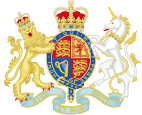
This article is part of the series:
Politics and government of
EnglandGovernance
The official region consists of the following subdivisions:
Map Ceremonial county Unitary authority Metropolitan districts 
1. Northumberland Tyne and Wear * 2. Newcastle upon Tyne, 3. Gateshead, 4. North Tyneside, 5. South Tyneside, 6. Sunderland Durham 7. Durham 8. Darlington 9. Hartlepool 10. Stockton-on-Tees (North of River Tees) North Yorkshire
(part only)10. Stockton-on-Tees (South of River Tees) 11. Redcar and Cleveland 12. Middlesbrough Key: * = metropolitan county
The Association of North East Councils (former North East Assembly until 2009) is based in central Newcastle upon Tyne.
Recent history
The region was created in 1994 and was originally defined as Northumberland, Tyne and Wear, County Durham and Cleveland. As part of a reform of local government, Cleveland has since been abolished and several unitary districts created.
The region is now considered to consist of four distinct 'sub-regions':
- County Durham (plus Darlington)
- Northumberland
- Tyne and Wear
- Teesside (formerly part of Cleveland, now associated with North Yorkshire and County Durham)
A referendum in November 2004 as to whether a directly-elected regional assembly should be set up for North East England resulted in a decisive "no" vote. The total number of people voting against the plans was 696,519 (78%), while 197,310 (22%) voted in favour.
Deputy Prime Minister of that time, John Prescott, admitted his plans for regional devolution had suffered an "emphatic defeat". Conservative spokesman for the regions Bernard Jenkin said the vote would mean the end of plans for a North East Assembly. He told the BBC: "The whole idea of regional government has been blown out of the water by this vote".[1]
Biodiversity
The region has a rich natural heritage, its diverse landscape includes maritime cliffs and extensive moorland containing a number of rare species of flora and fauna. Of particular importance are the saltmarshes of Lindisfarne, the Tees Estuary, the heaths, bogs and traditional upland hay meadows of the North Pennines, the distinctive Arctic-alpine flora of Upper Teesdale, the Farne Islands (which contain rare seabirds such as the Roseate Tern) and the magnesian limestone grasslands of East Durham - a habitat found nowhere else in the world.
The North East also features woodland such as Kielder Forest, the largest man-made forest in Europe. This is located within Northumberland National Park and contains an important habitat for the endangered red squirrel. The region is the English stronghold of black grouse and contains 80-90% of the UK population of yellow marsh saxifrage. A recently created site for bird watching is Rainton Meadows.
Demographics
Although the North East region has the lowest rate of HIV infection in the UK[citation needed], it has the highest rate of heart attacks for men, and for lung cancer for women in England (just below Scotland), and the highest lung cancer rate for men in the UK[citation needed]. It has the joint highest birth rate for women under 20 in the UK (with Wales). It also has the highest youth unemployment (ages 16–24) in the UK, and the second highest trade union membership for men (after Northern Ireland). For English students in higher education, those for the North East are most likely (72%) to pick a university in their home region; Scotland is the highest with 95% staying in their home country. The North East also has the highest proportion of Christians in the UK[citation needed].
Teenage pregnancy
By region, the North East has the highest rate of teenage pregnancy in England[citation needed]. Inside the region, the top-tier authority with the highest rate is Hartlepool, with Easington the former council district with the highest rate. The top-tier authority with the lowest rate is Northumberland and the council district with the lowest rate was the former Tynedale in Northumberland[citation needed].
Social deprivation
The region has the most multiple deprivation in England, and, as measured by the Indices of deprivation 2007, it has a significantly higher percentage of Lower Layer Super Output Areas in the 20% (quintile) most deprived districts than the 20% least deprived districts in England[2] - with the highest percentage of LSOAs in deprived areas in England, with North West England then Greater London being the next highest. However only Greater London has a smaller percentage of areas in the 20% least deprived districts than the North East.
The most deprived council districts in 2007, before County Durham and Northumberland became unitary authorities and as measured by the LSOA data,[3] in the region are, in descending order – Easington (district) (7th in England), Middlesbrough (9th), Hartlepool (23rd), Wear Valley (33rd), Sunderland (35th), Newcastle upon Tyne (37th), South Tyneside (38th), Wansbeck (46th), Redcar and Cleveland (50th), Gateshead (52nd), Sedgefield (borough) (54th), Derwentside (73rd), Blyth Valley (80th), and Stockton on Tees (98th).
The least deprived council districts in 2007 were, in descending order – Tynedale, Castle Morpeth, Teesdale (district), then Alnwick (district). These four districts ceased to exist in April 2009. At a county level, which is now the case as the North East now contains no district councils since 2009, Northumberland is the least deprived, followed by North Tyneside.
Unemployment is a severe problem in the North East, leading to many children growing up in workless households (where no adult works). Easington has the highest rate in the country, with 40.3% of households with children having no working adult, followed by Sedgefield with 34%.[4]
In March 2011, it was found that the region has the highest overall unemployment claimant rate in England, with 5.0%, and second in the UK to Northern Ireland (5.2%). Inside the region, the highest unemployment rate is Middlesbrough with 7.7% (the second highest in England), followed by Hartlepool with 7.4%, Redcar and Cleveland on 6.4%, the former Wansbeck district with 6.1%, and South Tyneside with 6.0%. The lowest claimant count is in the former district of Tynedale (2.0%).[5]
Elections
The North East is a strongly Labour-voting area. 43% of the electorate voted Labour in the 2010 election, with 23% each voting Conservative and Liberal Democrat. Apart from Labour's virtual domination, the Conservatives have Hexham and Stockton South, and the Lib Dems have Berwick-upon-Tweed and Redcar
At the 2009 European election, Labour got 25%, the Conservatives 20%, the Lib Dems 18%, and UKIP 15%.
Constituencies in North East England (29) Labour (25) Bishop Auckland · Blaydon · Blyth Valley · City of Durham · Darlington · Easington · Gateshead · Hartlepool · Houghton and Sunderland South · Jarrow · Middlesbrough · Middlesbrough South and East Cleveland · Newcastle upon Tyne Central · Newcastle upon Tyne East · Newcastle upon Tyne North · North Durham · North Tyneside · North West Durham · Sedgefield · South Shields · Stockton North · Sunderland Central · Tynemouth · Wansbeck · Washington and Sunderland West
Conservative (2) Liberal Democrats (2) Transport
Rail
The East Coast Main Line cuts through the region with stops at Newcastle, Durham and Darlington, providing fast connections to London and Edinburgh. The region is also served by the Durham Coast Line which connects Sunderland, Hartlepool and Middlesbrough with the main line. East Coast, based in York and the only current nationalised railway company in the UK, has services along the full length of the ECML, to Edinburgh and beyond and is the operator of most of the stations on the route. Grand Central Railway since December 2007 has linked Sunderland, and Teesside with London, being non-stop from York onwards; it does not have electric trains and uses the Northallerton–Eaglescliffe Line and Durham Coast Line. Local services along these lines, and most other local routes in the North East are provided by Northern, based in Manchester. First TransPennine Express, also based in Manchester, have long-distance services from Newcastle and Middlesbrough to Manchester, via West Yorkshire.
The Tyne and Wear Metro is a light rail network which serves the metropolitan county of Tyne and Wear, with stations in both Newcastle and Sunderland city centres, other towns and suburbs in the county, as well as at Newcastle Airport and other attractions such as the St James' Park, Stadium of Light, and Gateshead International Stadium
Road
The two main arterial carriageways, the A1 and the A19, mirror the railway trajectory. However, north of Morpeth, the A1 is single carriageway. The Tyne Tunnel was opened as a single-carriageway in 1967, and a new tunnel, built alongside, was opened in February 2011. The A1 Newcastle Western Bypass was completed in the early 1990s. The A66 connects Teesside with Darlington. The A68 takes a cross-country central route over the North Pennines and Cheviot Hills to Scotland, often following the Roman road Dere Street.
Sea
There is a ferry terminal at North Shields, accessed via the A187 from the Tyne Tunnel. DFDS operate two ferries a day to Amsterdam and, until 1 September 2008, one a day on the Stavanger - Haugesund - Bergen route.
Air
The two main airports are Newcastle Airport located north of the city near Ponteland and Durham Tees Valley Airport located east of Darlington.
Transport policy
As part of the national transport planning system, the Regional Assembly is required to produce a Regional Transport Strategy (RTS) to provide long term planning for transport in the region. This involves region wide transport schemes such as those carried out by the Highways Agency and Network Rail.[6] Within the region the local transport authorities plan for the future by producing Local Transport Plans (LTP) which outline their strategies, policies and implementation programmes.[7] The most recent LTP is that for the period 2006-11. In the North East region the following transport authorities have published their LTP online: Darlington,[8] Durham,[9] Hartlepool,[10] Middlesbrough,[11] Northumberland,[12] Redcar and Cleveland,[13] Stockton-on-Tees[14] and Tyne and Wear.[15]
Economy
The North East region has the lowest GVA per capita in England, and second lowest in the United Kingdom only behind Wales. The economy was for several decades unusually highly focused on two industries, ship building and coal mining (in Durham and Northumberland; hence the phrase taking coals to Newcastle. UK Coal is about to start surface mining at Steadsburn near Widdrington Station and Stobswood in Northumberland.
The former regional electricity company Northern Electric is now managed by CE Electric UK, based in Penshaw.
Land use in County Durham and Northumberland is agricultural in the majority. North East Ambulance Service is based just west of the A1 Newcastle bypass, north of the Tyne near Newburn and Blaydon, also the home of NHS North East and the local regional development agency - One NorthEast. The Great North Air Ambulance, based in Penrith and Durham Tees Valley also includes Cumbria. The region's Business Link (BLNE) has been based since October 2007 at Dawdon, south of Seaham on the A182.
Electricity generation in North East England Generating
sitesActiveProposed/FutureActiveClosedBerwick upon Tweed · Blyth · Carville · Chopwell Colliery · Close · Consett · Darlington · Derwenthaugh Coke Works · Dunston · Forth Banks · Hebburn · Horden Colliery · Lemington · Mainsforth Colliery · Manors · Morrison Busty Colliery · Neptune Bank · Newburn Steelworks · North Tees · Ouston Colliery · Pandon Dene · Philadelphia · South Shore Road · South Shields · Stella · Sunderland · Vane Tempest Colliery · WhinfieldProposed/FutureEston Grange (Gasification)Refused/ShelvedActiveProposed/FutureConocoPhillips Teesside · Thor CogenerationRefusedNewburnActiveClosedActiveRefusedActiveWiltonActiveTeesside · Path Head landfillClosedFutureNorth Eastern Energy Recovery Centre · Wilton 11RefusedActiveBlyth Harbour · Blyth Offshore · Broom Hill · Great Eppleton · Hare Hill · High Sharpley · High Volts · Holmside Hall · Kirkheaton · Langley Park · Tow Law · Trimdon Grange · Walkway · West DurhamFutureBlyth Harbour (repowering) · Butterwick Moor · Great Eppleton (repowering) · Haswell Moor · Kiln Pit Hill · Lynemouth · Royal Oak · TeessideProposedBarmoor South · Green Rigg · Kielder · Moorsyde · Ray Hill · South Sharpley · Steadings · Teeswind North · The Isles · Todd Hill · West Ancroft · Wingates
Organisations
and personnelA. Reyrolle & Company · C. A. Parsons and Company · Northern Powergrid · Charles Algernon Parsons · Charles Hesterman Merz · Clarke Chapman · John Theodore Merz · L J Couves & Partners · Merz & McLellan · NaREC · Newcastle and District Electric Lighting Company · North Eastern Electric Supply Company · Northern Electric · Northern Engineering Industries · Pre-nationalisation North East electric power companies
This is a table showing the trend in regional gross value added (GVA) at current basic prices published by the Office for National Statistics with figures in millions of British Pounds Sterling.[16]Year Regional Gross Value Added[17] Agriculture[18] Industry[19] Services[20] 1999 27,437 225 9,104 18,106 2002 31,167 228 9,416 21,433 2005 36,204 211 10,367 25,625 2007 40,916 278 11,120 28,250 Teesside
In Teesside, ICI was next to Wilton on a huge site between Eston and Redcar, and also in Billingham. Petroplus refine oil at the Port Clarence (formerly Teesside) Refinery. Teesport is the second busiest port in the country. Hartlepool has a nuclear power station, and there is a gas turbine power station and a CHP power station on the ICI Wilton site. The area at Wilton and Teesmouth is a vast chemicals processing site, and has recently diversified into being the UK's leading site for (renewable) biofuel research. Purdey's and Amé were made by Britvic in Hartlepool (former Orchid Drinks) until February 2009, when production was moved to Chelmsford in Essex.
Huntsman Tioxide has a large plant at Greatham that makes titanium dioxide, and its European headquarters are in Billingham. Aldous Huxley's visit to the former ICI plant in Billingham inspired him to write Brave New World. The Billingham Manufacturing Plant now makes fertiliser for Growhow (owned by Kemira of Finland and CF Industries, former Terra, of the USA), using 1% of the UK's natural gas. Marlow Foods make Quorn and KP Snacks make McCoy's Crisps in Billingham. Santander UK has its mortgages division in Thornaby-on-Tees. Corus Group makes steel on Teesside, notably Redcar, and makes pipes in Hartlepool. Tetley Tea have had their only tea bag factory in the UK at Eaglescliffe, in the borough of Stockton-on-Tees, since 1969. It is the largest tea bag factory in the world, making 18 billion tea bags a year. The distribution centre is at nearby Newton Aycliffe in County Durham.
Tyne and Wear
Main article: List of companies based in Newcastle upon TyneSwan Hunter until 2006 made ships in Wallsend, but still designs ships. Scottish & Newcastle was the largest UK-owned brewery until April 2008 when it was bought by Heineken and Carlsberg, and has the Newcastle Federation Brewery in Dunston, which produced Newcastle Brown Ale; production moved to Tadcaster in September 2010. De La Rue have their largest banknote printing facility at Team Valley. Offshore Group Newcastle make oil platforms. The government's child benefit office is in Washington, which lost two data discs in 2007. Northern Rock, which became a bank in 1997, is based in Gosforth and there is the Newcastle Building Society. Greggs, the bakers, is in Gosforth. Findus UK until 2009 was based on the Balliol Business Park in Longbenton, home of P&G's detergent technical centre and one of its global business centres, and a tax credits call centre for HMRC. The previous Government National Insurance Contributions Office (demolished and replaced in 2000) in Longbenton had a 1 mile (1.6 km) long corridor.[citation needed] There is also Be-Ro and the large Go-Ahead Group bus company is in central Newcastle. Nestlé have a chocolate factory in Fawdon. The MetroCentre, the largest shopping centre in Europe, is in Dunston. BAE Systems Land and Armaments (former Vickers-Armstrongs) on Scotswood Road in Scotswood is the main producer of British tanks, such as the Challenger 2.
Siemens make steam turbines at the CA Parsons Works in South Heaton, Newcastle. Sir Charles Parsons invented the steam turbine in 1884, and he developed an important local company. Domestos (sodium hypochlorite) was originated in Newcastle in 1929 by William Handley, and distributed from the area for many years. Barratt Developments is in Benwell, Newcastle, and Bellway plc is in Seaton Burn in North Tyneside. The Sage Group, who make accounting software are based in Newcastle. J. Barbour & Sons make outdoor clothing in South Shields.
Evans Halshaw, the car dealership, is in Sunderland. Also in Sunderland, between North Hylton and Washington on an old airfield, is a car factory owned by Nissan Motor Manufacturing (UK) Ltd and the outdoor clothing company, Berghaus, in Castletown. Smith Electric Vehicles, the world's leading manufacturer of electric vehicles[citation needed] originated in Washington. Liebherr build cranes next to the Wear at Deptford. Vaux Breweries, who owned Swallow Hotels, closed in 1999. ScS Sofas are on Borough Road. There are many call centres in Sunderland, notably EDF Energy at the Doxford International Business Park, home of the headquarters of Arriva, the large international transport company, and Nike UK.
Northumberland
Ashington has the Alcan Lynemouth Aluminium Smelter with the Lynemouth Power Station next door. Hammerite and Cuprinol are made by ICI Paints in Prudhoe. Procter & Gamble in Seaton Delaval have a main factory making aftershave (Hugo Boss) and hair dye (Clairol and Nice 'n Easy). The site was formerly owned by Shultons, who originated Old Spice, and were bought by P&G in 1990.
County Durham
GlaxoSmithKline has a site at Barnard Castle that makes pharmaceuticals. KP Snacks (owned by United Biscuits) make Phileas Fogg snacks in Consett. Black & Decker used to have a large factory at Spennymoor but production was moved to the Czech Republic in 2002. Electrolux closed its cookers factory there in 2008, with production moving to Poland. Northumbrian Water is in Pity Me, Framwellgate Moor. Since 2007 RF Micro Devices (RFMD) have made electronic wafers on the Heighington Lane Business Park at Newton Aycliffe, with the site formerly owned by Fujitsu before 1999.
Darlington stayed relatively un-industrialised throughout the 20th century with finance and manufacturing being the main elements of its economy. Today Darlington is recognised for its railways more than anything as the first steam-hauled public passenger railway in the world was constructed through the town. Cleveland Bridge & Engineering Company which is responsible for the Sydney Harbour Bridge and Tyne Bridge is still based in Darlington. The Orange mobile network provider also has a large site in Darlington. Argos and Aldi have major national depots in Darlington. Cummins, an American engineering company, also has a large site in Darlington. The town centre continues to develop into a successful retail hub for the region with a large new £110m shopping centre, 'The Oval', on the way in the next few years. The national safeguarding authority has set up its national office here, which vets people on jobs for vulnerable people. The Student Loans Company has recently set up in Lingfield Point, and Magnet Kitchens is in Lingfield in the east of the town. Darlington's economy is one of the most improving in the country.[citation needed]
Education
Primary education
There are just over 250 nursery/primary schools in the County Durham area of the north east, and these range from schools with their own nursery, to schools that are either infant only, or junior only, for example, Ouston Junior School[21]. In areas such as Gosforth, there are first schools, such as Archibald First School, which have no years 5 nor 6, and therefore educate children up to the age of 8 and 9.
Secondary education
The North East education system consists of largely comprehensive schools but with a number of private and independent schools found in Newcastle, Sunderland, Durham, Darlington, Stockton and Northumberland in particular.
There are around 125,000 at secondary schools in the region - the lowest in England, with the next lowest being the East Midlands. The truancy at its schools is a mixed picture, with it having the second highest overall rate for urban areas, after Yorkshire and the Humber. However for rural areas, it has the lowest overall truancy rate in England. Inside the region Middlesbrough has the highest rate with 7.2% persistent truants, which is the second highest in England after Manchester (7.3%). Next highest is Newcastle upon Tyne, with 6.4%, then the former district of Wansbeck, with 6.3%
At GCSE level, the region performs similar to other largely urban areas although generally results are below the national average. Middlesbrough generally performs the worst with average results well below the national average for England. LEAs in the North East have improved (comparatively) at GCSE in recent years. Newcastle, and Hartlepool are the next lowest. In 2010, Durham performed the best, with (in order) Darlington, Gateshead, Northumberland, and South Tyneside also above the England average.
The better schools at GCSE tend to be faith schools, including St Thomas More RC in Blaydon, Emmanuel City Technology College (a selective independent state school) in Gateshead, All Saints C of E School in Ingleby Barwick, English Martyrs School and Sixth Form College in Hartlepool, St Bede's Catholic School and Sixth Form College in Lanchester, County Durham, and the Carmel RC Technology College in Darlington. Other well performing schools in the region include Whitley Bay High School the Macmillan Academy in Middlesbrough, Park View Community School in Chester-le Street, and the Hurworth School near Darlington. All Northumberland schools have a sixth-form along with a three-tier system of education. Many schools in the area (especially in Teesside, Sunderland and South Tyneside) do not have a sixth form. Middlesbrough and Newcastle have the most people that pass no GCSEs.
At A-level, local education authorities in the north east are improving, but produce results substantially below other areas of the England. In 2010, Sunderland performed the best, with consistently good results, followed by Darlington which are both some way above the England average (and unrepresentative of most areas in the North East). Darlington is particularly noted for Queen Elizabeth Sixth Form College, which is one of the most highly rated colleges in England. Sunderland and its catholic schools all do reasonably well at A level, similar to other catholic schools in the area. Newcastle was also above the England average and Stockton on Tees produced results just over the England average. Newcastle does significantly better at A-level than GCSE, and is consistently improving, and conversely Gateshead does much worse at A-level than GCSE, with the second lowest A-level results in the region in 2009, slightly better than Middlesbrough. South Tyneside had in previous years been consistently the worst performing LEA at A-level in the region.
The independent and private schools in the area perform highly. Dame Allan's Schools, The King's School, Tynemouth, Royal Grammar School (NRGS) and Durham School are all members of the prestigious The Headmasters' and Headmistresses' Conference. The Central Newcastle High School in addition to the Royam Grammar School were named in the top 100 independent schools nationally in 2006. Durham School is considered to be one of the oldest schools in the UK, and it's Old Boys were the founding members of the original Newcastle Falcons Rugby club. Finally, the highly exclusive Mowden Hall preparatory School is situated in Northumberland, and is noted for getting many pupils into top UK public schools. The private schools out-perform the state schools in the urban areas.[citation needed] In the region, school children from Northumberland are most likely to attend university, followed by Stockton on Tees and North Tyneside.
Top fifteen state schools in North East England (2010 A-level results)
- Carmel RC Technology College, Hummersknott, Darlington (917)
- St Robert of Newminster Roman Catholic School, Washington
- Durham Johnston Comprehensive School
- The King Edward VI School, Morpeth
- Conyers' School, Yarm
- St. Anthony's Girls School, Sunderland
- Berwick Community High School
- Queen Elizabeth Sixth Form College, Darlington
- Haydon Bridge Community High School and Sports College
- Egglescliffe School, Eaglescliffe
- St. Benet Biscop Catholic High School, Bedlington
- Queen Elizabeth High School, Hexham
- St. Cuthbert's High School, Newcastle-upon-Tyne
- English Martyrs School and Sixth Form College, Hartlepool
- Park View Community School, Chester-le-Street (816)
Further education
There are sixteen further education colleges in the region.[22] The two main further education colleges are Newcastle College and New College Durham.
Tertiary education
At the higher education level the North East contains a number of internationally acclaimed universities. These include Durham University, the third oldest university in England and often ranked among the ten leading UK universities; Newcastle University, a member of the Russell Group, and the newer universities of Northumbria University, University of Sunderland and Teesside University, which was voted Best University in the United Kingdom in 2009 at the Times Higher Education awards. There are no higher education colleges in the region.
The main university in the region is Newcastle University.[23] It offers the broadest range of courses and has the largest research budget. The next largest university, by funding, is Durham University which has a research grant of about 70% that of Newcastle's, and fairly large compared to many universities. For total income, Newcastle again gets the most, followed by Durham, with Sunderland having the least.
Over 50% of students in the region come from the region, and around 35% are from other regions. At first degree level, around 55% are from the North of England (around 30% are from the region). The transfer of students across the region's boundary is mostly a net import of students, as few students in the region go elsewhere (due to the distances involved). 80% of students native to the region study in the North of England, with Yorkshire and the Humber being more popular than the North West, and around 55% staying in the region. A higher proportion of students in the region, compared to elsewhere in England, come from so-called low participation neighbourhoods; Durham University has the least from these neighbourhoods. Northumbria University has the most students, followed by Teesside University. Durham University has the fewest total students.
Once graduated, almost 60% will stay in the region, with 10% each going to either Yorkshire or London. Both these areas are accessible via the East Coast Main Line.
Local media
Local media include:
- Regional television comes the BBC North East and Cumbria region, which has the regional evening Look North programme from Spital Tongues in Newcastle. The ITV region, Tyne Tees Television, has the evening programme North East Tonight from Gateshead.
- BBC Radios Newcastle and Tees (a.k.a. Radio "T"). National radio comes from Bilsdale on the North York Moors for Teesside, Pontop Pike in County Durham for Tyne and Wear, and Chatton near Wooler for Northumberland. These transmitters are also the main TV transmitters.
- Commercial radio stations such as: Metro Radio (Newcastle), Real Radio (North East) (Gateshead), 105-106 Capital FM (former Galaxy North East in Wallsend), Rock Radio (Digital), TFM Radio (Thornaby-on-Tees), Sun FM (Sunderland), and Star Radio North East (Darlington). Digital radio comes from the Bauer Tyne & Wear and Bauer Teesside multiplexes.
- Community radio stations also operate in the area such as: NE1fm (Newcastle), Radio Teesdale (Teesdale, County Durham) Spark FM (Sunderland),.
- Local regional newspapers are the Evening Chronicle (Newcastle) , Sunderland Echo (Sunderland), The Journal (Newcastle), Evening Gazette (Middlesbrough), Shields Gazette (South Shields), Hartlepool Mail, The Northern Echo (Darlington) and the Darlington and Stockton Times.
- New media company Great North News Services (Newcastle upon Tyne).
Reference line notes
- ^ "North East votes 'no' to assembly". BBC News. 2004-11-05. http://news.bbc.co.uk/1/hi/uk_politics/3984387.stm. Retrieved 2010-05-20.
- ^ http://www.communities.gov.uk/documents/communities/pdf/576659.pdf
- ^ Indices of deprivation[dead link]
- ^ By GRAEME WILSON, Deputy Political Editor (2010-11-05). "Workless homes with children". Thesun.co.uk. http://www.thesun.co.uk/sol/homepage/news/3212819/A-third-of-homes-have-no-workers.html. Retrieved 2011-07-25.
- ^ Claimant count
- ^ "Regional Transport Strategy: the National Picture". Government Office for the North East. http://www.gos.gov.uk/gone/transport/rts/?a=42496. Retrieved 2009-05-07.
- ^ "The LTP Process". Department for Transport. http://www.dft.gov.uk/pgr/regional/ltp/theltpprocess. Retrieved 2009-05-07.[dead link]
- ^ "Darlington 2006-11 Local Transport Plan". Darlington Borough Council. http://www.darlington.gov.uk/Transport/Transport+Policy.htm. Retrieved 2009-05-08.
- ^ "Durham 2006-11 Local Transport Plan". Durham County Council. http://www.durham.gov.uk/Pages/Service.aspx?ServiceId=5685. Retrieved 2009-05-08.
- ^ "Hartlepool 2006-11 Local Transport Plan". Hartlepool Borough Council. http://www.hartlepool.gov.uk/site/scripts/documents_info.php?documentID=105&pageNumber=2. Retrieved 2009-05-08.
- ^ "Middlesbrough 2006-11 Local Transport Plan". Middlesbrough Council. http://www.middlesbrough.gov.uk/ccm/navigation/transport-and-streets/transport-planning/. Retrieved 2009-05-08.
- ^ "Northumberland 2006-11 Local Transport Plan". Northumberland County Council. http://www.northumberland.gov.uk/default.aspx?page=1425. Retrieved 2009-05-08.
- ^ "Redcar and Cleveland 2006-11 Local Transport Plan". Redcar and Cleveland Borough Council. http://www.redcar-cleveland.gov.uk/main.nsf/Web+Full+List/876E02D44951507C80256FFD002C0188?OpenDocument. Retrieved 2009-05-08.
- ^ "Stockton-on-Tees 2006-11 Local Transport Plan". Stockton-on-Tees Borough Council. http://www.stockton.gov.uk/citizenservices/transport/ltp/. Retrieved 2009-05-08.
- ^ "Tyne and Wear 2006-11 Local Transport Plan". Tyne and Wear LTP. http://www.tyneandwearltp.co.uk/. Retrieved 2009-05-08.
- ^ http://www.statistics.gov.uk/downloads/theme_economy/CRC2008ALL.pdf
- ^ Components may not sum to totals due to rounding
- ^ includes hunting and forestry
- ^ includes energy and construction
- ^ includes financial intermediation services indirectly measured
- ^ http://www.ouston-jun.durham.sch.uk/ Junior schools in North East
- ^ http://www.skillsnortheast.co.uk Skills North East
- ^ http://www.hefce.ac.uk/pubs/hefce/2007/07_18/outputNE.pdf
External links
 Districts of North East England
Districts of North East EnglandCounty Durham 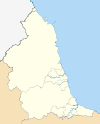
Northumberland Tyne and Wear North Yorkshire  United Kingdom topics
United Kingdom topicsGeography Administrative Physical Lakes and lochs · Mountains · Rivers · Volcanoes · Great Britain · Geology of Great Britain · Geology of Northern Ireland
History Maritime · Economic · Military · British Empire · Timeline
Politics · Government Economy Pound sterling · London Stock Exchange · Banks (Bank of England) · Taxation · Transport · Communications · Economic geography · Mining · Energy · Budget
Military Society · Demography Cities · Crime · Ethnic groups · Immigration · Languages · Poverty · Social structure · Towns
Culture Art · Cinema · Cuisine · Identity · Literature · Media · Music · Sport · Television · Theatre · Public holidays
England Northern Ireland Scotland Wales History · Welsh Government · Welsh Assembly · First Minister · Politics · Education · Health care · Religion · Tourism
Categories:- North East England
- NUTS 1 statistical regions of England
- NUTS 1 statistical regions of the European Union
Wikimedia Foundation. 2010.

